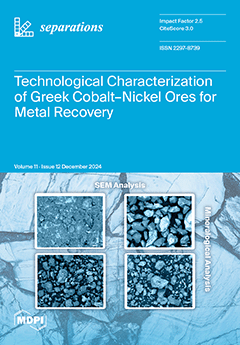Odor emission has become a major issue in waste transfer stations. Hydrogen sulfide, methyl mercaptan (MM), and dimethyl disulfide (DMDS) are the main odorous gases. They have a low odor threshold and are difficult to remove. In this study, pine bark biochar was
[...] Read more.
Odor emission has become a major issue in waste transfer stations. Hydrogen sulfide, methyl mercaptan (MM), and dimethyl disulfide (DMDS) are the main odorous gases. They have a low odor threshold and are difficult to remove. In this study, pine bark biochar was produced and modified with metal ions, including Ni
2+, Ti
2+, Mn
2+, Zn
2+, Mg
2+, and Cu
2+. It was then used for the removal of hydrogen sulfide, methyl mercaptan, and dimethyl disulfide. Among all modifications, the Cu
2+ modified biochar showed the best sorption capacity, and the maximum sorption amounts were 20.50 mg/g for H
2S, 36.50 mg/g for MM, and 57.98 mg/g for DMDS. To understand the adsorption, BET, SEM, and XPS of the original and modified biochar were performed. This illustrated that modification with Cu
2+ increased the surface area and porosity, thus enhancing the adsorption capacity. In the alkaline absorption study, it was found that the removal of the three odor gases increased with the pH increase. Based on the results, a combined process called absorption–adsorption was established to treat the odor gas generated in a local waste transfer station. Thirty-one gas components were detected in the odor gas of the waste transfer station. The process proceeded for 30 days, and these gas components were not found in the effluent during treatment. Regarding H
2S, MM, and DMDS, they were not detected even after 90 days. This indicates the high adsorption capacity of the modified biochar toward the three odor gases. In addition, the process is simple and easy to operate. This suggests that it is suitable for treating odor in places where there is no technician, and the odor needs efficient treatment. The study provides a feasible alternative for domestic waste transfer stations to control the odor problem.
Full article





